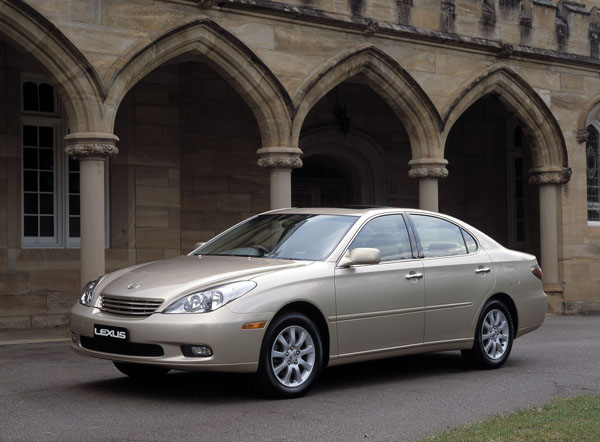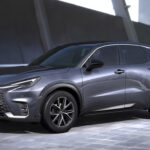The Lexus ES300 offers value in a prestige Japanese car built to a high standard. However it achieves lower cost because in its earlier models it was a Toyota Camry/Vienta with a different style of body and some mechanical upgrades. There are sufficient body similarities between the Lexus and Toyota for them to share a family resemblance. Which is not surprising because using the same ‘skeleton’ makes it all but impossible to hide the fact.
The ES was criticised by some motoring journalists due to this family resemblance, which is a bit unfair as the same guys and gals don’t launch into criticisms against Audi with comparisons between its models and lower cost Volkswagens that share platforms with Audi.
The supreme smoothness and quietness that characterises the big Lexus LS Series aren’t quite there in the ES Series, but they don’t lag all that far behind. The huge price difference between the two models the ES pretty attractive to many.
Pleasant enough to drive and ride in, the ES makes no pretence at being a sports machine. Handling is on the soft side and is dominated by front-wheel-drive understeer if you push it too hard. Similarly, there is a slight reluctance to change direction promptly. The new 1996 model was improved over the original but is still not one for the keen punter.
Interior room of the Lexus ES is good without being outstanding. Try the back seat for yourself if you’re going to be transporting adults back there. Being a front-wheel-drive car, unlike the other Lexus passenger sedans, gives the ES an advantage in legroom and boot space.
When introduced in June 1992, the Lexus ES was pretty upmarket for its days, with leather trim, climate-controlled air conditioning, a high quality sound system, powered front seats and cruise control. The series two Lexus ES, introduced in October 1996, saw the introduction of an additional, more affordable model. The lower-priced ES300 S (without leather trim, alloy wheels, and a few other goodies) and the more upmarket ES300 LXS.
Lexus ES imports to Australia stopped in 2006 as the new model of that year wasn’t built with the steering wheel on the right. Things improved in late 2013 when the next series Lexus ES Line was an all-new model built on a unique platform. Imports to Australia were resumed and a few examples of the 2013 are now appearing on the used-car market.
Two Lexus ES models were introduced at that time, a 3.5-litre V6 petrol engine replaced the 3.0-litre that had retained that capacity since 1992.
Lexus push in the hybrid field saw the introducing of the ES 300h as a serious part of the 2013 lineup. It combined a 2.5-litre Atkinson cycle four-cylinder petrol engine with nickel-metal-hydride batteries.
ES 300’s 3.0-litre V6 engine is by far the most common on the Australian used-car market. It’s silky smooth, and reasonably powerful, though rather too oriented towards the top end of the rev range, in the European manner in the original series. It was fully renewed for the October 1996 update and again in 2001.
Power transmission is by a sophisticated four-speed automatic that operates in exemplary fashion. This was upgraded to a five-speed unit with the 2001 ES 300, then to six forward speeds in 2013.
Over the years the number of Lexus dealerships in Australia has significantly increased. The company began its operations in the major capital cities, but later expended into larger country cities as well. The latter a smart move as Toyotas have extraordinary presence in country Australia and Lexus benefits from that.
Senior technicians at Toyota dealerships can carry out work if you’re not in an area serviced directly by Lexus.
Servicing and repairs are best left to professional mechanics.
Insurance is generally moderate in price, reflecting the type of conservative driver to whom this car appeals.
Japanese cars don’t have the prestige of European ones, yet are almost invariably better built and substantially cheaper. Tradition can’t be bought, but in its 25 years on the market Japanese Lexus has shaken up the long-established Europeans.
WHAT TO LOOK FOR
Check for damage to the body work and interior trim and expect even the oldest cars to be in very good condition. If not they may have had an uncaring owner in their past.
Make sure the engine starts quickly and idles smoothly, indeed, virtually imperceptibly. Check the automatic transmission operates quietly and smoothly.
Feel for steering that is precise in its operation and works smoothly. Listen for unusual noises and look for the slightest sign of anything out of the ordinary.
Be sure the brakes stop the car in a straight line and that the anti-lock ABS system pulses on fast stops.
Be sure to get a quote for even the most minor of faults as these can be pricey at times.
Having done your own initial checks, call in either a Lexus specialist or an inspector from your motoring association for a final check.
CAR BUYING TIP
If you’re living in a country area and are considering a relatively unusual car it makes sense to enquire about spares and repairs early in your research stage.














